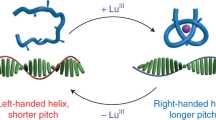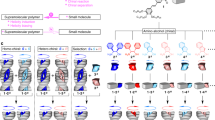Abstract
Helices have long attracted the attention of chemists, both for their inherent chiral structure and their potential for applications such as the separation of chiral compounds or the construction of molecular machines. As a result of steric forces, polymeric o-phenylenes adopt a tight helical conformation in which the densely packed phenylene units create a highly condensed π-cloud. Here, we show an oligomeric o-phenylene that undergoes a redox-responsive dynamic motion. In solution, the helices undergo a rapid inversion. During crystallization, however, a chiral symmetry-breaking phenomenon is observed in which each crystal contains only one enantiomeric form. Crystals of both handedness are obtained, but in a non-racemic mixture. Furthermore, in solution, the dynamic motion of the helical oligomer is dramatically suppressed by one-electron oxidation. X-ray crystallography of both the neutral and oxidized forms indicated that a hole, generated upon oxidation, is shared by the repeating o-phenylene units. This enables conformational locking of the helix, and represents a long-lasting chiroptical memory.
This is a preview of subscription content, access via your institution
Access options
Subscribe to this journal
Receive 12 print issues and online access
$259.00 per year
only $21.58 per issue
Buy this article
- Purchase on Springer Link
- Instant access to full article PDF
Prices may be subject to local taxes which are calculated during checkout






Similar content being viewed by others
References
Yashima, E., Maeda, K., Iida, H., Furusho, Y. & Nagai, K. Helical polymers: synthesis, structures, and functions. Chem. Rev. 109, 6102–6211 (2009).
Yuki, H., Okamoto, Y. & Okamoto, I. Resolution of racemic compounds by optically active poly(triphenylmethyl methacrylate). J. Am. Chem. Soc. 102, 6356–6358 (1980).
Okamoto, Y. Chiral polymers for resolution of enantiomers. J. Polym. Sci. A 47, 1731–1739 (2009).
Yashima, E., Maeda, Y. & Okamoto, Y. Synthesis of poly[N-(4-ethynylbenzyl)ephedrine] and its use as a polymeric catalyst for enantioselective addition of dialkylzincs to benzaldehyde. Polym. J. 31, 1033–1036 (1999).
Reggelin, M., Doerr, S., Klussmann, M., Schultz, M. & Holbach, M. Helically chiral polymers: a class of ligands for asymmetric catalysis. Proc. Natl Acad. Sci. USA 101, 5461–5466 (2004).
Roelfes, G. & Feringa, B. L. DNA-based asymmetric catalysis. Angew. Chem. Int. Ed. 44, 3230–3232 (2005).
Yamamoto, T. & Suginome, M. Helical poly(quinoxaline-2,3-diyl)s bearing metal-binding sites as polymer-based chiral ligands for asymmetric catalysis. Angew. Chem. Int. Ed. 48, 539–542 (2009).
Yashima, E. & Maeda, K. Chirality-responsive helical polymers. Macromolecules 41, 3–12 (2008).
Miwa, K., Furusho, Y. & Yashima, E. Ion-triggered spring-like motion of a double helicate accompanied by anisotropic twisting. Nature Chem. 2, 444–449 (2010).
Green, M. M. et al. A helical polymer with a cooperative response to chiral information. Science 268, 1860–1866 (1995).
Yashima, E., Matsushima, T. & Okamoto, Y. Poly((4-carboxyphenyl)acetylene) as a probe for chirality assignment of amines by circular dichroism. J. Am. Chem. Soc. 117, 11596–11597 (1995).
Prince, R. B., Barnes, S. A. & Moore, J. S. Foldamer-based molecular recognition. J. Am. Chem. Soc. 112, 2758–2762 (2000).
Waki, M., Abe, H. & Inouye, M. Translation of mutarotation into induced CD signals through helix inversion of host polymers. Angew. Chem. Int. Ed. 46, 3059–3061 (2007).
Petitjean, A., Nierengarten, H., van Dorsselaer, A & Lehn, J.-M. Self-organization of oligomeric helical stacks controlled by substrate binding in a tobacco mosaic virus like self-assembly process. Angew. Chem. Int. Ed. 43, 3695–3699 (2004).
Hou, J.-L. et al. Hydrogen bonded oligohydrazide foldamers and their recognition for saccharides. J. Am. Chem. Soc. 126, 12386–12394 (2004).
Maurizot, V., Dolain, C. & Huc, I. Intramolecular versus intermolecular induction of helical handedness in pyridinedicarboxamide oligomers. Eur. J. Org. Chem. 2005, 1293–1301 (2005).
Okoshi, K., Sakurai, S.-I., Ohsawa, S., Kumaki, J. & Yashima, E. Control of main-chain stiffness of a helical poly(phenylacetylene) by switching on and off the intramolecular hydrogen bonding through macromolecular helicity inversion. Angew. Chem. Int. Ed. 45, 8173–8176 (2006).
Yamamoto, T., Yamada, T., Nagata, Y. & Suginome, M. High-molecular-weight polyquinoxaline-based helically chiral phosphine (PQXphos) as chirality-switchable, reusable, and highly enantioselective monodentate ligand in catalytic asymmetric hydrosilylation of styrenes. J. Am. Chem. Soc. 132, 7899–7901 (2010).
Kim, H.-J., Lee, E., Park, H.-S. & Lee, M. Dynamic extension–contraction motion in supramolecular springs. J. Am. Chem. Soc. 129, 10994–10995 (2007).
Maxein, G. & Zentel, R. Photochemical inversion of the helical twist sense in chiral polyisocyanates. Macromolecules 28, 8438–8440 (1995).
Li, J., Schuster, G. B., Cheon, K.-S., Green, M. M. & Selinger, J. V. Switching a helical polymer between mirror images using circularly polarized light. J. Am. Chem. Soc. 122, 2603–2612 (2000).
Pijper, D. & Feringa, B. L. Molecular transmission: controlling the twist sense of a helical polymer with a single light-driven molecular motor. Angew. Chem. Int. Ed. 46, 3693–3696 (2007).
King, E. D., Tao, P., Sanan, T. T., Hadad, C. M. & Parquette, J. R. Photomodulated chiral induction in helical azobenzene oligomers. Org. Lett. 10, 1671–1674 (2008).
Marsella, M. J., Rahbarnia, S. & Wilmot, N. Molecular springs, muscles, rheostats, and precessing gyroscopes: from review to preview. Org. Biomol. Chem. 5, 391–400 (2007).
Hida, N. et al. Helical, chiral polyisocyanides bearing ferrocenyl groups as pendants: synthesis and properties. Angew. Chem. Int. Ed. 42, 4349–4352 (2003).
Gomar-Nadal, E., Veciana, J., Rovira, C. & Amabilino, D. B. Chiral teleinduction in the formation of a macromolecular multistate chiroptical redox switch. Adv. Mater. 17, 2095–2098 (2005).
Wittig, G. & Lehmann, G. Über die Reaktionsweise von 2,2′-Dilithium-diphenyl gegenüber Metallchloriden; Gleichzeitig ein Beitrag zur Synthese von Poly-o-phenylenen. Chem. Ber. 90, 875–892 (1957).
Winkler, H. J. S. & Wittig, G. Preparation and reactions of o-dilithiobenzene. J. Org. Chem. 28, 1733–1740 (1963).
Wittig, G. & Klar, G. Über die Reaktionsweise von 2,2′-Dilithium-biphenyl gegenüber Metallhalogeniden, II. Liebigs Ann. Chem. 704, 91–108 (1967).
Blake, A. J., Cooke, P. A., Doyle, K. J., Gair, S. & Simpkins, N. S. Poly-orthophenylenes: synthesis by Suzuki coupling and solid state helical structures. Tetrahedron Lett. 39, 9093–9096 (1998).
Ormsby, J. L., Black, T. D., Hilton, C. L., Bharat & King, B. T. Rearrangements in the Scholl oxidation: implications for molecular architectures. Tetrahedron 64, 11370–11378 (2008).
Geerts, Y., Klärner, G. & Müllen, K. Electronic Materials: The Oligomer Approach Ch. 1 (Wiley-VCH, 1998).
Goto, H., Furusho, Y., Miwa, K. & Yashima, E. Double helix formation of oligoresorcinols in water: thermodynamic and kinetic aspects. J. Am. Chem. Soc. 131, 4710–4719 (2009).
Voisin, E. & Williams, V. E. Do catechol derivatives electropolymerize? Macromolecules 41, 2994–2997 (2008).
Ibuki, E., Ozasa, S. & Murai, K. Studies of polyphenyls and polyphenylenes. I. The syntheses and infrared and electronic spectra of several sexiphenyls. Bull. Chem. Soc. Jpn 48, 1868–1874 (1975).
Viedma, C. Chiral symmetry breaking during crystallization: complete chiral purity induced by nonlinear autocatalysis and recycling. Phys. Rev. Lett. 94, 065504 (2005).
Noorduin, W. L., Vlieg, E., Kellogg, R. M. & Kaptein, B. From Ostwald ripening to single chirality. Angew. Chem. Int. Ed. 48, 9600–9606 (2009).
Uwaha, M. & Katsuno, H. Mechanism of chirality conversion by grinding crystals: Ostwald ripening vs crystallization of chiral clusters. J. Phys. Soc. Jpn 78, 023601 (2009).
Kondepudi, D. K., Kaufman, R. J. & Singh, N. Chiral symmetry breaking in sodium chlorate crystallization. Science 250, 975–976 (1990).
Kondepudi, D. K. & Asakura, K. Chiral autocatalysis, spontaneous symmetry breaking, and stochastic behavior. Acc. Chem. Res. 34, 946–954 (2001).
Sakamoto, M. et al. Breaking the symmetry of axially chiral N-aryl-2(1H)-pyrimidinones by spontaneous crystallization. Angew. Chem. Int. Ed. 42, 4360–4363 (2003).
Hunter, C. A. & Sanders, J. K. M. The nature of π–π interactions. J. Am. Chem. Soc. 112, 5525–5534 (1990).
Milosevich, S. A., Saichek, K., Hinchey, L., England, W. B. & Kovacic, P. Coordination in benzene dimer cation radical. J. Am. Chem. Soc. 105, 1088–1090 (1983).
Hiraoka, K., Fujimaki, S., Aruga, K. & Yamabe, S. Stability and structure of benzene dimer cation (C6H6)2+ in the gas phase. J. Chem. Phys. 95, 8413–8418 (1991).
Graf, D. D., Duan, R. G., Campbell, J. P., Miller, L. L. & Mann, K. R. From monomers to π-stacks. A comprehensive study of the structure and properties of monomeric, π-dimerized, and π-stacked forms of the cation radical of 3′,4′-dibutyl-2,5′′-diphenyl-2,2′:5′,2′′-terthiophene. J. Am. Chem. Soc. 119, 5888–5899 (1997).
Itagaki, Y., Benetics, N. P., Kadam, R. M. & Lund, A. Structure of dimeric radical cations of benzene and toluene in halocarbon matrices: An EPR, ENDOR and MO study. Phys. Chem. Chem. Phys. 2, 2683–2689 (2000).
Yamazaki, D., Nishinaga, T., Tanino, N. & Komatsu, K. Terthiophene radical cations end-capped by bicyclo[2.2.2]octane units: formation of bent π-dimers mutually attracted at the central position. J. Am. Chem. Soc. 128, 14470–14471 (2006).
Song, C. & Swager, T. M. π-Dimer formation as the driving force for calix[4]arene-based molecular actuators. Org. Lett. 10, 3575–3578 (2008).
Chebny, V. J., Shukla, R., Lindeman, S. V. & Rathore, R. Molecular actuator: redox-controlled clam-like motion in a bichromophoric electron donor. Org. Lett. 11, 1939–1942 (2009).
Das, T. N. Monomer and dimer radical cations of benzene, toluene, and naphthalene. J. Phys. Chem. A 113, 6489–6493 (2009).
Acknowledgements
This work was supported by KAKENHI (21350108). The authors thank S. Ohkoshi and K. Nakabayashi (University of Tokyo) for the measurement of the ESR spectrum.
Author information
Authors and Affiliations
Contributions
T.F. and T.A. designed the work. E.O., T.F. and T.A. wrote the paper. E.O., H.S., S.A. and A.K. performed the experiments. Single-crystal X-ray diffraction studies were carried out through the collaboration of D.H., M.Y. and K.H., A.M., H.U. and K.Y. were responsible for DFT calculations.
Corresponding authors
Ethics declarations
Competing interests
The authors declare no competing financial interests.
Supplementary information
Supplementary information
Supplementary information (PDF 1736 kb)
Supplementary information
Crystallographic data for compound OP8Br (CIF 38 kb)
Supplementary information
Crystallographic data for compound OP8NO2 (neutral) (CIF 41 kb)
Supplementary information
Crystallographic data for radical cation OP8NO2•+, counter anion SbF6- (CIF 44 kb)
Rights and permissions
About this article
Cite this article
Ohta, E., Sato, H., Ando, S. et al. Redox-responsive molecular helices with highly condensed π-clouds. Nature Chem 3, 68–73 (2011). https://doi.org/10.1038/nchem.900
Received:
Accepted:
Published:
Issue Date:
DOI: https://doi.org/10.1038/nchem.900
This article is cited by
-
Photonically active bowtie nanoassemblies with chirality continuum
Nature (2023)
-
Mechanical single-molecule potentiometers with large switching factors from ortho-pentaphenylene foldamers
Nature Communications (2021)
-
Potentially helical imidazole-containing conjugated oligomers: synthesis, optical properties, and conformation
Polymer Journal (2019)
-
Synthesis, characterization, and self-assembly behavior of poly(m-phenylene)s with terthiophene and chiral side chains
Polymer Bulletin (2019)
-
Dynamic multistimuli-responsive reversible chiral transformation in supramolecular helices
Scientific Reports (2018)



